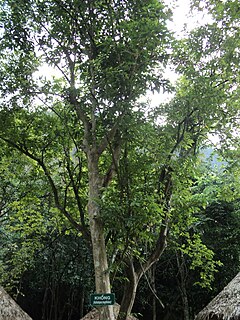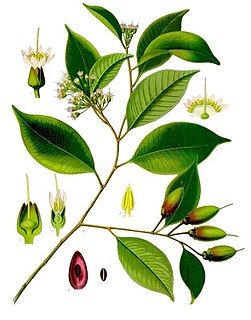Gonystylus, is a southeast Asian genus of about 30 species of hardwood trees also known as ramin, melawis (Malay) and ramin telur (Sarawak).
Paracroton is a genus of flowering plants in the Euphorbiaceae first described as a genus in 1859. It is native to South and Southeast Asia, as well as New Guinea.
- Paracroton integrifolius(Airy Shaw) N.P.Balakr. & Chakr. - Kerala, Tamil Nadu
- Paracroton pendulus(Hassk.) Miq. - India, Sri Lanka, Myanmar, Thailand, Malaysia, Borneo, Sumatra, Philippines
- Paracroton sterrhopodus(Airy Shaw) Radcl.-Sm. & Govaerts - W New Guinea
- Paracroton zeylanicus(Müll.Arg.) N.P.Balakr. & Chakr. - Sri Lanka
Wetria is a plant genus of the family Euphorbiaceae, first described as a genus in 1858. It is native to Australia, New Guinea and Southeast Asia.
- Wetria australiensis P.I.Forst. - Papua New Guinea, Queensland
- Wetria insignis (Steud.) Airy Shaw - Thailand, Myanmar, Peninsular Malaysia, Borneo, Sumatra, Java, Lesser Sunda Islands, Philippines
Chondrostylis is a plant genus of the family Euphorbiaceae first described as a genus in 1897. It is native to Thailand, Peninsular Malaysia, Sumatra and Borneo.
- Chondrostylis bancanaBoerl. - Bangka, Kalimantan Tengah
- Chondrostylis kunstleri(King ex Hook.f.) Airy Shaw - S Thailand, W Malaysia, Borneo, Sumatra
Trigonopleura is a plant genus of the family Peraceae, first described as a genus in 1887. It is native to Indonesia, Malaysia, and the Philippines.
- Trigonopleura dubia(Elmer) Merr. - Philippines
- Trigonopleura macrocarpaAiry Shaw - Sarawak
- Trigonopleura malayanaHook.f. - Peninsular Malaysia, Sumatra, Bangka, Borneo, Sulawesi
Cheilosa is a monotypic plant genus of the family Euphorbiaceae first described as a genus in 1826. Only one species is recognized: Cheilosa montana, native to Southeast Asia.
Neoscortechinia is a plant genus of the family Euphorbiaceae first described as a genus in 1897. It is native to Southeast Asia and Papuasia.
- Neoscortechinia angustifolia(Airy Shaw) Welzen - Sabah, Kalimantan
- Neoscortechinia forbesii(Hook.f.) S.Moore - New Guinea, Admiralty Islands, Bismarck Archipelago, Solomon Islands
- Neoscortechinia kingii(Hook.f.) Pax & K.Hoffm. - W Malaysia, Sumatra, Borneo
- Neoscortechinia nicobarica(Hook.f.) Pax & K.Hoffm. - Nicobar Islands, Myanmar, Malaysia, Indonesia, Philippines, W New Guinea
- Neoscortechinia philippinensis(Merr.) Welzen - Myanmar, Thailand, Malaysia, W Indonesia, Philippines
- Neoscortechinia sumatrensisS.Moore - W Malaysia, N. Sumatra, Simeuluë, Borneo

Koilodepas is a genus of plant of the family Euphorbiaceae first described as a genus in 1856. It is native to Southeast Asia, India, Hainan, and New Guinea.
Muricococcum is a genus of plant of the family Euphorbiaceae first described as a genus in 1956. It contains only one known species, Muricococcum sinense, native to southern China and northern Vietnam.
Syndyophyllum is a plant genus of the family Euphorbiaceae, first described as a genus in 1900. It is native to Sumatra, Borneo, and New Guinea.
- Syndyophyllum excelsum K.Schum. & Lauterb. - New Guinea
- Syndyophyllum occidentale Welzen - Sumatra, Borneo
Botryophora is a genus of plant of the family Euphorbiaceae first described as a genus in 1888. It contains only one known species, Botryophora geniculata, native to Thailand, Myanmar, Malaysia, Borneo, Sumatra, and Java.
Ptychopyxis is a genus of plant of the family Euphorbiaceae first described in 1861. It is native to Southeast Asia and New Guinea.
- Ptychopyxis arborea - Borneo
- Ptychopyxis bacciformis - Vietnam, Borneo, Sumatra, Philippines, W Malaysia
- Ptychopyxis caput-medusae - W Malaysia
- Ptychopyxis chrysantha - New Guinea
- Ptychopyxis costata - Borneo, Sumatra, W Malaysia
- Ptychopyxis glochidiifolia - Sumatra, Sarawak, Brunei, Kalimantan Timur
- Ptychopyxis grandis - Borneo
- Ptychopyxis javanica - S Thailand, Vietnam, W Malaysia, Borneo, Sumatra, Java
- Ptychopyxis kingii - W Malaysia, E Sumatra, Sarawak, Sabah
- Ptychopyxis plagiocarpa - S Thailand, S Myanmar
Endospermum is a genus of plants, under the family Euphorbiaceae and the monotypic subtribe Endosperminae first described as a genus in 1861 It is native to E + S + SE Asia, Papuasia, Queensland, and certain islands of the W Pacific.

Dimorphocalyx is a genus of plants under the family Euphorbiaceae first described as a genus in 1861. It is native to Southeast Asia, Hainan, India, Sri Lanka, New Guinea, and Queensland.
Pimelodendron is a plant genus in the family Euphorbiaceae first described as a genus in 1855. It is native to insular Southeast Asia, Thailand, Papuasia, and Queensland.

Aporosa is a genus of flowering plant belonging to the family Phyllanthaceae first described as a genus in 1825. It is native to China, the Indian Subcontinent, Southeast Asia, Papuasia, and Queensland.
Ashtonia is a genus of flowering plant belonging to the family Phyllanthaceae first described as a genus in 1968. It is native to the Malay Peninsula and Borneo.
- Ashtonia excelsa Airy Shaw - Borneo
- Ashtonia praeterita Airy Shaw - S Thailand, W Malaysia

Breynia is a plant genus in the family Phyllanthaceae, first described in 1776. It is native to Southeast Asia, China, the Indian Subcontinent, Papuasia, Australia, and the island of Réunion.

Hanguana is a genus of flowering plants with a dozen known species. It is the only genus in the family Hanguanaceae.

Payena is a genus of plants in the family Sapotaceae described as a genus in 1844.






